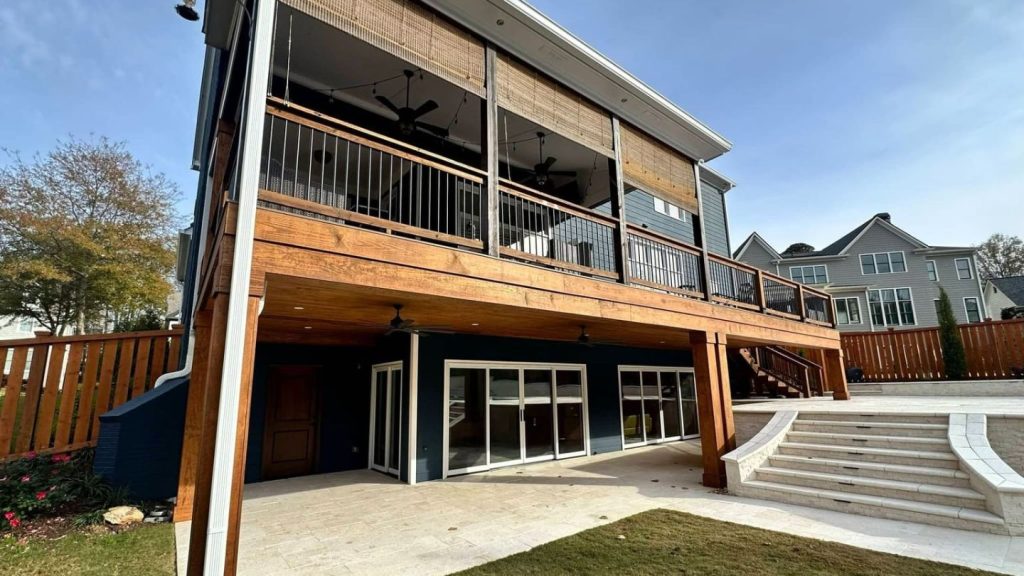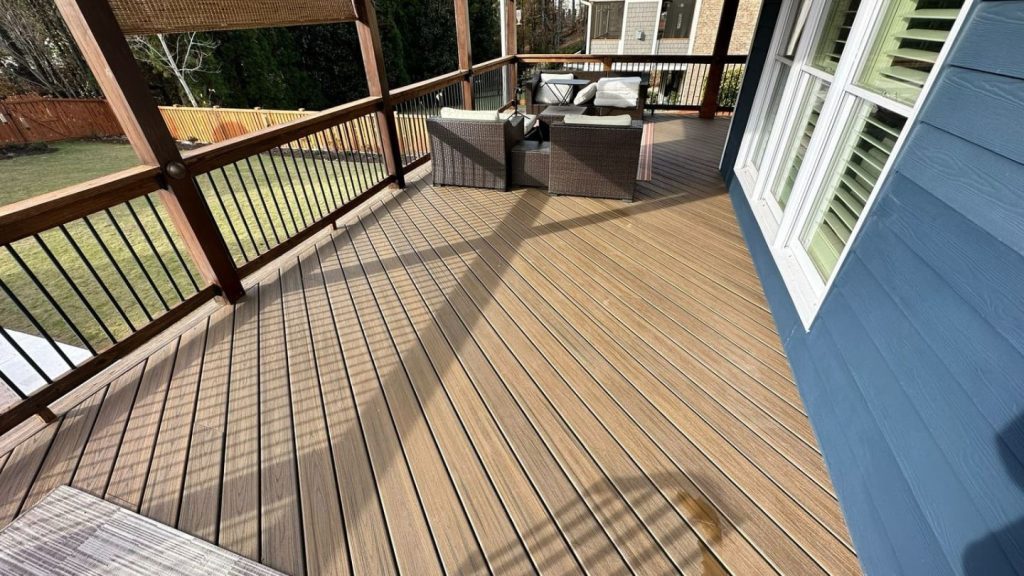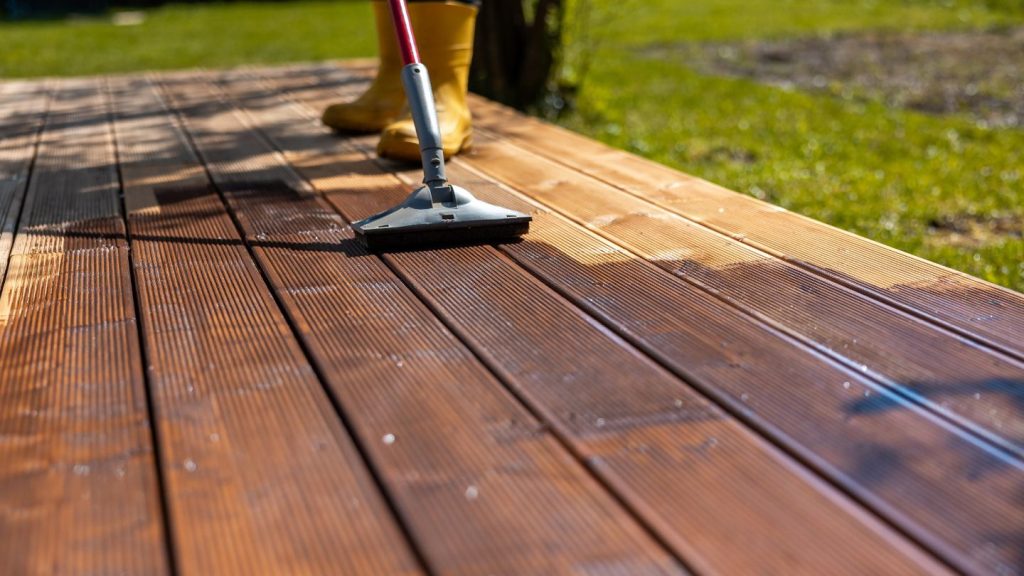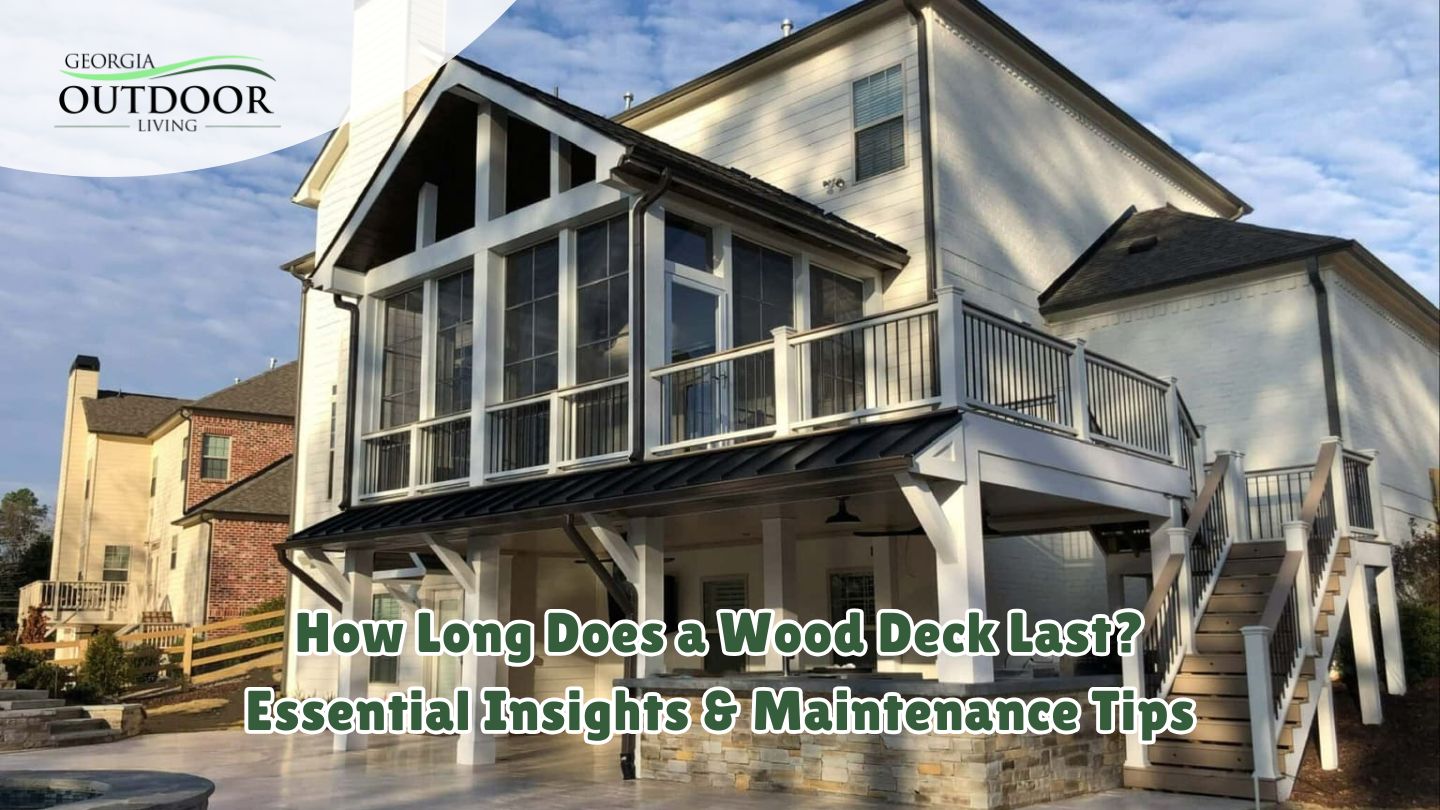A wood deck can last anywhere from 10 to 50 years, but the exact deck’s lifespan depends on various factors. In this blog, we explore the types of wood decks, what influences their longevity, and how you can extend their life with proper care and regular maintenance.
Key Takeaways
- The life expectancy of a wood deck typically ranges from 10 to 50 years, influenced by factors like the type of wood, climate, and maintenance practices.
- Regular maintenance, including cleaning, sealing, and inspections, is crucial to prolonging the deck’s integrity and preventing damage from weather and pests.
- Choosing the right decking material and ensuring consistent care can make a significant difference in how long your wooden deck lasts.
Understanding Wood Deck Lifespan

The durability of a wood deck can vary significantly, ranging from 10 to 50 years. Several factors influence the deck surface and its integrity over time. The type of wood, climate, and how well the deck is maintained, all play a role. When properly maintained, wooden decks can last for decades, creating a beautiful outdoor living space that serves your family for years to come.
There are several types of deck materials available, each offering unique benefits. Whether it’s pressure-treated lumber, cedar, or hardwood decking, the choice of decking material will impact not only the deck’s durability but also its aesthetic appeal. Below are some of the most popular options:
Pressure-Treated Wood Decks
A pressure-treated wood deck is one of the most popular and cost-effective choices for homeowners. These decks are made from pressure-treated pine or other treated wood species that have been chemically enhanced to resist rot and pests. Pressure-treated wood is incredibly durable, typically lasting between 15 to 20 years when properly maintained.
To ensure your pressure-treated deck lasts even longer, it’s essential to perform annual maintenance, including sealing, power washing, and periodic inspections. With the right care, your pressure-treated wood deck can exceed its expected lifespan and look great for decades.
Cedar Decks
Cedar decks are naturally resistant to moisture and rot, making them a popular choice for outdoor settings. When properly cared for, these decks can last 20 to 25 years. Cedarwood offers a natural appearance with a beautiful reddish hue, but like all wood decks, regular cleaning and sealing are crucial to maintain its integrity and prevent weathering.
Although cedar decks are resistant to rot, they do require maintenance to preserve their natural beauty and prevent damage from sun exposure and moisture. For homeowners who appreciate the beauty of wood, cedar wood is an excellent choice for a long-lasting deck.
Redwood Decks

Redwood decks are an ideal option for those seeking a deck that offers both durability and elegance. Redwood is naturally resistant to rot and pests, ensuring the deck’s lifespan extends to 20 to 30 years with the right deck maintenance. Redwood decks are known for their rich, vibrant color and are a standout feature in any outdoor space.
Proper care for redwood decks involves regular inspections, cleaning, and the application of a protective sealant to maintain its natural beauty and prevent exposure to the elements from affecting the deck boards.
Hardwood Decking
Hardwood decking options are some of the most incredibly durable and long-lasting materials available. When properly maintained, hardwood decking can last anywhere from 25 to over 50 years. An ipe deck is a top choice for homeowners seeking a high-end, low-maintenance solution. Though hardwoods can be more expensive than pressure-treated wood, their durability makes them a worthwhile investment for many.
These deck boards are dense and resistant to both weather and pests, providing a long-lasting foundation for any outdoor living space. To maintain an ipe deck, it’s essential to seal and clean it regularly, keeping it in pristine condition for decades.
Key Factors Influencing Wood Deck Longevity
Several factors contribute to how long your wood deck can last. These include:
- The type of wood used: Different types of wood have varying levels of durability. Cedar, redwood, and hardwoods tend to last longer than softer woods.
- Climate: Extreme weather conditions, such as the scorching sun or heavy rainfall, can impact your deck. Sun exposure can cause wood to crack and fade, while excess moisture can lead to rot.
- Maintenance practices: Regular cleaning, sealing, and inspections are critical to ensuring your deck remains properly maintained.
- Pest control: Insects, such as wood-boring insects and termites, can damage your deck if left unchecked. Choosing naturally resistant materials or applying treatments can help prevent infestations.
By paying attention to these factors, you can take proactive steps to extend the life expectancy of your deck.
Climate Impact on Deck Longevity
The climate in your area plays a significant role in determining how long your deck will last. Prolonged sun exposure can cause the wood to dry out and crack, while excessive moisture can promote rot. Cedar decks and redwood decks are more resistant to moisture, but all wood decks will benefit from regular maintenance to keep them in top shape.
When planning your deck’s placement, consider the balance between sun and shade. This will help the wood dry properly without absorbing too much moisture. If your deck is placed in an area with little airflow, it may absorb more moisture and be more prone to rot. Taking these environmental factors into account during construction can significantly impact the deck’s lifespan.
Maintaining Your Deck

Regular maintenance by professional services is essential for prolonging the lifespan of any wood deck. Here are a few essential tasks that professionals can handle:
- Regular cleaning: Hire professional services to clean your deck at least twice a year to remove dirt, mold, and debris. They use appropriate tools and solutions to gently scrub the surface, avoiding harsh chemicals that could damage the wood.
- Sealing: Professionals can apply a protective sealant to prevent moisture damage and UV degradation. A water-repellent sealant helps resist rot and maintain the wood’s natural resistance, ensuring it is applied evenly and effectively.
- Inspections: Conduct regular professional inspections to check for signs of wear, including loose nails, rot, or any structural issues. Early detection of problems allows for timely repairs by experts, preventing further damage and ensuring the deck’s integrity.
Summary
In conclusion, the life expectancy of a wood deck is influenced by several factors, such as the type of wood, climate, and maintenance practices. Whether you opt for pressure-treated wood, cedar, redwood, or hardwoods, ensuring proper deck maintenance is essential to extending your deck’s lifespan.
At Georgia Outdoor Living, we are a premier deck contractor in Milton, specializing in crafting beautiful, durable wood decks that transform your outdoor space into a stunning retreat. Whether you’re looking to enhance your outdoor living space with a custom pressure-treated wood deck, cedar deck, or hardwood decking, our expert team provides personalized, professional services to ensure your deck lasts for decades. Contact us today to start your deck transformation!
Frequently Asked Questions
What maintenance practices are essential for extending the lifespan of a wooden deck?
Regular cleaning, applying sealant and stain, and performing periodic inspections are essential for proper care.
What are the benefits of using cedar for decking?
Cedar decks offer natural resistance to moisture and rot, making them a durable choice for outdoor spaces.
How does climate impact the lifespan of a wood deck?
Extreme sun exposure and moisture can shorten the lifespan of a deck. Proper placement and regular maintenance are key to maximizing its longevity.



